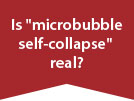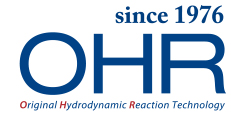[Wastewater treatment] Rubber porous air diffusers are not suitable for industrial wastewater
Rubber porous air diffusers are suitable for sewage treatment and NOT for industrial wastewater treatment
Rubber porous air diffusers are commonly used for wastewater treatment all over the world. They are either rod-shaped or
disk-shaped and have a rubber membrane with a lot of fine pores.
Rubber porous air diffusers were developed for sewage treatment. However they are also used for ‘industrial wastewater
treatment’ in extremely harsh conditions compared with sewage treatment. So the weaknesses not exposed in the sewage
treatment have become clear and beset by many problems. The following are the main problems of rubber porous air diffusers.
Rubber porous air diffusers clog and can not be used after only a short period of time at industrial wastewater treatment plants where the concentration of activated sludge (concentration of microorganisms) is high.
Rubber porous air diffusers are generally thought to have high Oxygen Transfer Rate (OTR). However this is incorrect. Even though OTR in clean water is high, OTR in actual wastewater significantly decreases. For industrial wastewater with high activated sludge concentration, the Alpha value* drops to about 0.2 in worst cases. (*Alpha value=0.2 means that when the OTR taken in clean water is 30%, the OTR in actual wastewater decreases to 6.0%)
Rubber porous air diffusers only discharge millimetre-sized air bubbles. Small bubbles have low buoyancy and do not rise quickly in water. Therefore the power to churn up the tank is weak and anaerobic sludge accumulates on the tank bottom.
The above problems are unnoticeable in sewage treatment plants where the activated sludge concentration is low, so with
rubber porous air diffusers it is relatively easy to obtain good results.
However, even if rubber porous air diffusers get high evaluation at the sewage treatment plants, they should not be used for
industrial wastewater in extremely harsh conditions. This is because rubber porous air diffusers are not suitable for industrial
wastewater.
This becomes quite obvious when analyzing ‘total ability of aeration’, in the case of using rubber porous air diffusers both for sewage treatment and for industrial wastewater treatment. ‘Total aeration ability’ can be judged by rating each item in the following analysis chart and seeing whether a large and even pentagon is formed or not. (It is the same as the nutritional balance in human meals. Even if one kind of nutrient is taken in excess, the human body can not use it. To keep good health, comprehensive nutritional balance is important. In order to maintain consistent wastewater treatment for a long time without energy loss and excess labor, it is necessary to evaluate air diffusers according to their total aeration ability.

Reference material: Can microbubble generator be used for aeration instead of air diffusers?
As a new aeration technology, there are companies advertising that microbubble generators can be used for aeration instead
of conventional air diffusers. Are microbubble generators superior to air diffusers?
This is also clearly understood by judging the analysis chart of total aeration ability, as below:

Water in the aeration tank has low oxygen so the OTR reaches almost 100% regardless of what kind of microbubble technology is used. Therefore, if you focus only on ‘OTR’, it is always evaluated as excellent. However, the disadvantage of the microbubble generator is that it can generate only a small volume of oxygen-rich water even with a lot of energy. Even if a small volume of oxygen-rich watch is delivered to a small area, this is insignificant considering the entire aeration tank may contain hundreds to thousands of tons of wastewater. Therefore, it makes no sense if you make microbubbles in the aeration tank using large amounts of energy.
It is meaningless to supply high concentration oxygen water to microorganisms if these microorganisms can not utilize it. High concentrations of oxygen can be poisonous to living things.
In fact, the amount of energy used for aeration in the tank was reduced by 20%. (We will provide details on request.) There are cases where microbubble technology works very effectively when it is used as a support for air diffusers, but the microbubble generators cannot be used as a substitute for air diffusers.
In addition, microbubbles are very small in size so lose most of their buoyancy, which means they rise very slowly. Therefore as microbubbles have no power to uniformly churn the whole tank, anaerobic sludge accumulates on the tank bottom depriving the microorganisms of oxygen. Even if high concentration of oxygen is supplied to a small area a large oxygen consumption zone (anaerobic zone) is inevitably created. Therefore wastewater treatment conditions will be poor due to lack of oxygen.












